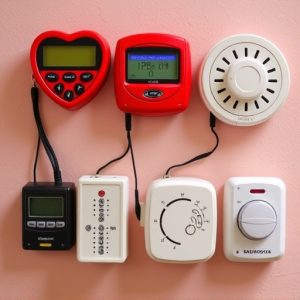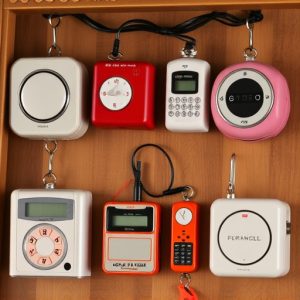Personal Alarms with Distress Signals: Enhancing Safety in Buildings and Public Spaces
The personal alarm range within buildings is a crucial element of individual safety, deterring intru…….
The personal alarm range within buildings is a crucial element of individual safety, deterring intruders and enabling quick assistance during emergencies. Modern devices with high-decibel sounds and distress signals create panic among aggressors while allowing users to escape and alert authorities. Integrated GPS tracking, automatic fall detection, and long-range communication ensure enhanced safety, especially for vulnerable people or those working alone. Smart buildings equipped with these alarms automatically detect and alert relevant authorities, improving response times. Legal considerations balance individual safety and public order, dictating decibel levels, activation mechanisms, and permissible areas for use to avoid false alarms and legal repercussions.
Mobile safety alarms with distress signals offer unprecedented personal protection, especially in today’s dynamic world. Understanding these compact yet powerful devices is crucial for navigating both everyday life and emergency situations. This article explores various aspects of mobile safety alarms, from their role in personal defense to advanced features, smart building integration, and legal considerations regarding the personal alarm range in public spaces. By delving into these topics, we empower individuals to make informed choices for enhancing their safety within buildings and outdoors.
- Understanding Mobile Safety Alarms: A Personal Defense System
- The Role of Distress Signals in Emergency Situations
- Features and Benefits of Advanced Personal Alarm Devices
- Integrating Alarms with Smart Buildings for Enhanced Security
- Legal and Safety Considerations for Personal Alarm Range in Public Spaces
Understanding Mobile Safety Alarms: A Personal Defense System
Mobile safety alarms equipped with distress signals are personal defense systems designed to protect individuals in various environments, including buildings and public spaces. These devices offer a simple yet effective solution for anyone facing an emergency situation, especially when help is not immediately available or accessible. By activating the alarm, users can quickly alert nearby people, security personnel, or emergency services of their location and distress.
The personal alarm range in buildings plays a crucial role in ensuring individual safety. Whether it’s a home, office, or any other structured setting, these alarms serve as a powerful deterrent against potential intruders and assailants. Their high-decibel sounds and automatic distress signals can create a sense of panic among aggressors while providing the user with a means to escape and request assistance promptly.
The Role of Distress Signals in Emergency Situations
In emergency situations, distress signals play a pivotal role, especially for individuals who are alone or unable to communicate effectively. These signals, often incorporated into personal safety alarms, serve as a lifeline in scenarios where help is urgently needed. When activated, distress signals can alert authorities and bystanders, providing critical information about the user’s location within a building. This functionality is particularly relevant in large or labyrinthine structures where navigating to safety might be challenging.
Personal alarm devices with distress signal capabilities offer peace of mind, ensuring that help arrives promptly during emergencies. The range at which these signals can be detected varies, but modern technology allows for effective communication even from extensive personal alarm ranges within buildings. This feature is a game-changer in fostering safety, especially for vulnerable individuals or those working in remote areas.
Features and Benefits of Advanced Personal Alarm Devices
Advanced personal alarm devices are revolutionizing safety, offering a range of features that extend far beyond traditional alarms. These innovative tools not only provide loud distress signals but also integrate GPS tracking, automatic fall detection, and long-range communication capabilities. This means users can easily transmit their location to emergency services even in large buildings where signal strength might be an issue.
The benefits are clear: enhanced personal safety, especially for individuals living or working alone; peace of mind knowing help is readily accessible; and quick response times during emergencies. These devices often come with user-friendly apps, allowing users to set up alerts, monitor battery life, and even customize distress signal sounds. This technology ensures that help can arrive promptly, no matter where a person might be within a building or its immediate surroundings.
Integrating Alarms with Smart Buildings for Enhanced Security
In today’s digital era, integrating mobile safety alarms with distress signals into smart buildings offers unprecedented security enhancements. This innovative approach leverages advanced technology to ensure faster response times during emergencies, as the system can automatically detect and alert relevant authorities upon activation. The personal alarm range in buildings becomes an effective tool, allowing occupants to quickly summon help from anywhere within the structure, be it a secluded area or a large labyrinthine space.
Such integration also promotes better navigation for emergency services, as smart building systems can provide precise locations of distress signals, even in complex structures with multiple floors and intricate layouts. This enhances safety not just for individuals but for entire communities, ensuring that help arrives promptly and efficiently.
Legal and Safety Considerations for Personal Alarm Range in Public Spaces
In public spaces, legal and safety considerations significantly influence the acceptable range for personal alarms with distress signals. Regulations vary across regions, but generally, there’s a balance between ensuring individual safety and maintaining public order. For instance, in buildings such as schools, hospitals, and offices, personal alarm ranges might be restricted to allow for controlled emergency responses while preventing unnecessary panic or false alarms. These regulations often dictate the decibel level, activation mechanisms, and areas where personal alarms can be used.
Compliance with local laws is crucial when deploying distress signals in public spaces. Excessive noise levels that disrupt daily activities or cause distress among bystanders could lead to legal repercussions. Moreover, personal alarms should be designed to respect privacy while providing urgent communication; this involves considering factors like activation distance and signal intensity to ensure they’re only activated in genuine emergencies.
Mobile safety alarms equipped with distress signals offer a powerful personal defense system, enhancing individual safety especially in emergency situations. Advanced features and benefits of these devices, combined with their integration into smart buildings, significantly contribute to enhanced security. However, it’s crucial to consider legal and safety guidelines regarding the acceptable personal alarm range in public spaces. Optimizing the deployment of these systems across buildings can create a safer environment for folks, serving as a game-changer in personal and community protection.


